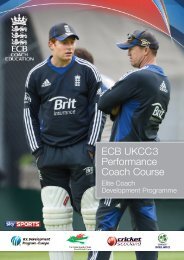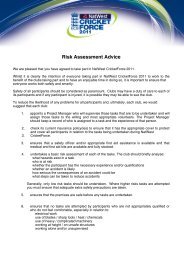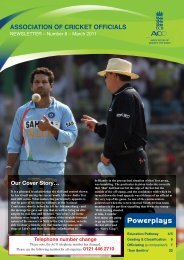ECB ACO Newsletter - Spring 2013
ECB ACO Newsletter - Spring 2013
ECB ACO Newsletter - Spring 2013
Create successful ePaper yourself
Turn your PDF publications into a flip-book with our unique Google optimized e-Paper software.
The worst over in the history of cricket and other awful ideas…We regularly read several publications and ‘The Spin’ by The Guardian writer Andy Bull is one of those. The latest editioncontained the article below which we thought would be of interest, and it makes Travis Birt in last year’s big bash (Edition13, Page 20) look a mere amateur….The “mad genius” line came to mind on Monday, as it was the anniversaryof the most hare-brained scheme ever concocted on acricket field. And there have been a few. Cricinfo has recently beenrunning a series on the most influential innovations the sport hasseen. So far, three lovely little essays have featured Gideon Haigh onthe leg glance, another on the switch hit from Ayaz Memon, and thelast on reverse swing, by Sidharth Monga. There’s a greater measureof genius than there is of madness in each of those.Flip that ratio around to find cricket’s worst innovations and youmight get a list that looks something like this:5) Dennis Lillee’s clunking aluminium bat (trade name: TheCombat – there’s a touch of genius in that, I’ll grant you), which reputedlyhad “no discernible sweet-spot” and caused such a stink thatit led to a change in the Laws.4) The Richie Benaud rule, which memorably scotched SouthAfrica’s chances of reaching the 1992 World Cup final when it tooka chase of 22 off 13 balls and, after a 12-minute rain break, andtransmogrified it into a target of 21 off one.3) The three-foot high boundary netting introduced by the MCCat Lord’s in 1900 to promote hitting shots along the ground. Truestory: if the ball reached the net, two runs were added to all the batsmenran. If the ball cleared it, the batsmen only got three runs intotal. Which meant that a lofted drive into the stands was worth lessthan an edge through the slips. Worse still, no one thought to cut ahole by the gate so that the incoming and outgoing batsmen couldget on or off the field.2) Sunil Gavaskar’s suggestion that the ICC should spice up ODImatches by introducing ‘Super Subs’, a wheeze which lasted all ofsix months, though it only took all of one match to spot that the teambatting second would automatically wring 10 overs out of theirNo11 then swap him for a specialist batsman.No1 though, a scheme so cunning that, as Blackadder would say,it was as cunning as a fox who has just been appointed Professor ofCunning at Oxford University, has to be the parachute-suit of a plandevised by Wellington on the final day of their Shell Shield matchagainst Canterbury at Christchurch on 21 February, 1990.If Wellington won the match, they would win the title too. Canterburywere chasing 291 in 59 overs, but by tea on the final afternoon,they were 108 for eight, and Wellington were worried the match waspetering out to a draw. So John Morrison, Wellington’s coach, andErv McSweeney, their captain, decided to lure Canterbury into tryingto win their match in the hope that the potential reward wouldencourage them to risk their last wickets. The best way to do this,they figured, was to bowl an over so bad that Canterbury would becompelled to cash in on it. Then Wellington would pull a rope-adope,and bring their best bowler back on just as the opposition werewithin sight of the win.Batsman Bert Vance was the hapless sap who was roped in tobowl, because, Morrison said afterwards, “he was coming to the endof his career and didn’t have averages to protect.”“The idea,” Morrison explained, was “to leave Canterbury about20 to get off the last over so that they might have a crack and throwaway their two wickets.” But “Bert overdid it somewhat. It’s fair tosay he embraced the instructions somewhat more than we imagined.”That was an understatement. Vance’s first delivery was a noball, delivered from two yards down the wicket. The batsman, LeeGermon, was so startled that he didn’t score off it. He did off thenext though, a full toss which he hit for four. Vance’s next 15 deliverieswere all no balls, which went for four, four, six, six, four, six,one, four, one, zero, six, six, six, six, and six.“He would just walk over the mark and toss up these no-ball fulltosses,”Morrison recalled. “It was a free slog to the batsmen, whogot fours and sixes in droves. It all got a bit chaotic. The scorers, theumpires and the players – it got to the point where none of them hada clue how many fair balls had been bowled or what the score was.It was an old-fashioned scoreboard, so there were boys running upand down ladders trying to keep up, but they were all over the place.Halfway through the over, no one knew what the hell was going onand I remember sitting on the side thinking, ‘Oh my God, we’regoing to throw this game away.’”Vance obviously had the same thought. His next two deliverieswere both legitimate, and he didn’t concede a run off either of them.Then there was another four, followed by one more dot and a singleto finish. There were 77 runs off the over, the last of them a littletwist of salt in the wound because it meant Germon would keep thestrike. He had scored 70 runs off the over, and took his score from75 to 145. Canterbury could have made even more, but in all theconfusion the umpires lost count and Vance got away with onlybowling five legitimate balls.Ewan Gray was left to bowl the last over. Canterbury needed 18from it to win the match, and Germon, his eye in, hit 17 from thefirst five deliveries. But the scoreboard was still kaput, with smokestreaming from the ears of the bamboozled scorers. Germon and hispartner Roger Ford, who had added just five runs to his own scorewhile his Germon had been busy making whoopee, were completelyoblivious to the fact that they only needed one run to win. So Fordblocked the final ball of the match, making it a draw with the scoresexactly level.“I nearly had heart failure when I learnt a little time after thegame that Canterbury only needed one to win and we had Vancebowling to a very leaky field,” Morrison explained. The over, themost expensive in the history of first-class cricket, was struck fromthe official records, though the ninth-wicket partnership of 182 isstill a record for the club. “I decided,” Morrison said ruefully, “thatthe tactic, while being innovative, was definitely a once-only.”<strong>ECB</strong> <strong>ACO</strong> would like to thank Andy for letting us reproduce hisarticle. You can receive ‘The Spin’ mailing by signing up online –http://www.guardian.co.uk/sport/signup/2010/mar/30/1Dennis Lillee argues with Mike Brearley over the legality of Lillee'saluminium bat. Lillee eventually switched to a traditional woodenbat, Australia v England, 1st Test, Perth, December 1979Albert Trott tries to maintain some dignity as he clambers over theexperimental netting during the match between MCC andLeicestershire at Lord'se-mail us at ecbaco@ecb.co.uk 19 contact us on 0121 446 2710












![Indoor Sports Halls with Cricket Provision [TS3] - Ecb - England and ...](https://img.yumpu.com/49070696/1/190x135/indoor-sports-halls-with-cricket-provision-ts3-ecb-england-and-.jpg?quality=85)



